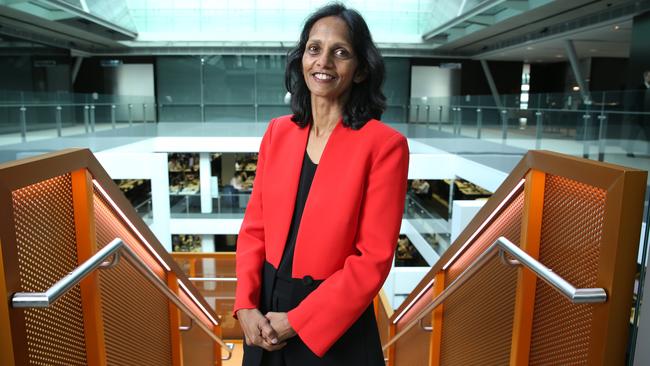Australia still a ‘good place’ for renewables spend, says Macquarie CEO Shemara Wikramanayake
As companies make a ‘massive move’ to lower emissions, Macquarie boss says efforts won’t be hindered by Australia’s energy policy.

Macquarie Group chief executive Shemara Wikramanayake says the asset management giant isn’t hindered by Australia’s energy policy and is ramping up renewable investments here, as economies and companies around the world make a “massive move” to lower emissions.
In Australia, Ms Wikramanayake said Macquarie had renewable exposure including wind farms, a large waste-to-energy project, the Snowy Hydro 2.0 plan and hydrogen projects in Western Australia’sPilbara region looking to make it available for transportation.
“We’re seeing ample opportunity to get invested here just as we are in the UK, European countries and the US. It’s different themes in every market,” she told The Weekend Australian.
“We’re seeing plenty of opportunity here to invest and for the private sector to get on and do things in renewables. We also are seeing opportunity in agriculture and you know there’s been world-leading research down here in terms of feedstock and how we can reduce methane emissions in farm animals.”
Ms Wikramanayake’s comments came as Macquarie’s full-year profit cracked $3bn for the first time, but it cautioned of potential headwinds in several of its divisions in the months ahead.
The results also outlined its target as a company to reaching net zero operational emissions by 2025, and ensure its financing activity to customers met a global goal of net zero emissions by 2050.
It also wants its $100m in coal-related loans — a negligible proportion of its asset base — to run off its books by 2024.
Ms Wikramanayake described the transition to cleaner forms of energy as a “glide path” that was different across jurisdictions, but said seismic change was now taking place in renewables and the electrification of transport industries.
“If anything we’re challenged to try and prioritise things and focus our attention, because there’s a massive move now in terms of the world having realised that climate change is upon us, and we need to adapt with mitigation solutions as well as building adaptation ones,” she said.
Macquarie’s profit for the 12 months to March 31 printed at almost $3.02bn, up from $2.73bn in the prior year, supported by a strong performance in its commodities and global markets unit.
The result was better than analysts expected and came in at the top end of upgraded guidance provided in February, largely due to a strong performance from its US gas trading unit. At the time, the group said it expected earnings to print 5 to 10 per cent higher in 2021 versus last year.
But Macquarie’s tendency not to provide group earnings guidance early in its year and concerns that growth would slow saw its shares dip 0.3 per cent to $158.45 on Friday.
Tribeca Investment Partners’ portfolio manager Jun Bei Liu still labelled it a “fantastic result” and noted Ms Wikramanayake had stuck to the Macquarie trend of underpromising and overdelivering on profits.
“She’s actually learned the play book from (former CEO) Nicholas Moore very well,” she said, noting strong equity markets and merger and acquisitions activity would buoy Macquarie’s investment banking arm in its current financial year.
“Macquarie Capital will continue to do well over the 12 months.”
Macquarie’s guidance across its divisions said commodities income would be “significantly down” after a strong 2021, and in the asset management unit base fees were expected to be flat and income hit by one-off items and integration costs on the Waddell & Reed acquisition.
In the investment banking and advisory arm, Macquarie expects improved transaction activity and asset sales, while in its banking and financial services division it cited “ongoing momentum” in loan and platform volumes.
“In totality, with the two largest divisions — MAM (asset management) and CGM (commodities and global markets) — guided to be down and significantly down, the other businesses are not large enough to offset,” Citigroup said. “Consequently, we expect consensus expectations for modest net profit after tax growth in FY22 will likely need to be revised lower.”
Macquarie’s total net operating income of grew 4 per cent to $12.8bn for the year, with income earned outside Australia accounting for 68 per cent of the total.
Assets under management declined 6 per cent to $563.5bn for 2021, weighed down by foreign exchange impacts and a fall in contractual insurance assets in Macquarie Investment Management.
The commodities and global markets division was the standout. The unit had a net profit contribution of $2.6bn in 2021, up 50 per cent, buoyed by higher revenues across the commodities platform with strong results across resources, agriculture and North American and European gas and power.
Macquarie’s asset management arm delivered a 5 per cent drop in profit for the year, after a record result in 2020. Despite gains on the sale of European rail assets and it being a record year for raising capital for investment funds, the unit’s earnings were weighed down by lower income from Macquarie’s stake in its aircraft leasing business and lower performance fees.
Macquarie Capital saw its net profit fall 15 per cent. The banking and financial services unit had a steady annual net profit contribution of $771m.
Macquarie did flag that conditions for selling assets had improved and it expected to book proceeds of $450m in its 2022 first half from divesting industrial and commercial energy meters in the UK.
Macquarie declared a final dividend of $3.35 per share, up from $1.80. That took 2021’s total dividend payments to $4.70 per share, 40 per cent franked, and reflected a second-half payout ratio of 60 per cent.
Separately, Macquarie has had to navigate a difficult period with regulators. Its banking unit was hit last month with a $500m charge after the banking regulator uncovered unacceptable and “multiple material breaches” of prudential and reporting standards.







To join the conversation, please log in. Don't have an account? Register
Join the conversation, you are commenting as Logout